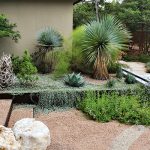Whether you’re looking for a solution for an existing Hill Country landscape or installing a brand new one, adjust expectations right at the start and plant for your particular landscape makeup.
It’s a sight so iconic that it could serve as a symbol: a blooming magnolia proudly planted in freshly laid sod at a brand new house on Bexar County’s sprawling north end.
But what does it symbolize when the soil it’s planted in has no hope of supporting it? Magnolias have big, fleshy roots and prefer deep, moist, acid soils like those in Houston — and completely unlike anything in the Hill Country, with its average soil depth of four inches or less.
But magnolias do have a lot in common with the landscapes being installed in new subdivisions: they remind us of somewhere else. Perhaps it’s a combination of Southern Living, optimism and nostalgia — we also see St. Augustine grass,Indian hawthorn, and even Asiatic jasmine being planted, overwatered and declining in the same steep rock hillsides on Bexar County’s north side. Many would be perfectly appropriate in East Texas, but here, they’re one of the chief causes of sprinklers being turned way, way up for plants that will never be able to perform without them (a condition we in water conservation term “life support” for plants that shouldn’t be there in the first place.)
In general, Houston-style hedges, groundcovers and turf grass all encounter the same problems in thin dry soil: they need consistent moisture and soil depth to look good across a large area, and without careful planning they can’t thrive in local microclimates. If they’re underlain by a combination of fill and sheer rock slabs, you’ll eventually see it — as a dead spot in the middle of a lawn, or dead shrubs in the middle of a hedge.
So why are they used in the first place? And why would you want a Houston landscape if you’d taken the trouble to move to the Hill Country?
In part, the answer can be attributed to tired formulas still used by developers, contractors and landscape architects, and by the plant material sitting on the back of the truck on the day the contractor throws in the shrubs.
If you’re looking for a solution for an existing landscape, it’s easy enough to replace a dying shrub with a more suitable alternative. But it you’re building a new house, it’s a good idea to remember at the start: the Hill Country is a different creature entirely, and it’s a good idea to adjust your expectations right at the start.
- Instead of the stereotypical GROUNDCOVER, use perennial landscape beds with combinations of color and evergreen structure.
- Instead of HEDGES and SCREENS, emphasize dense groupings of plants and preserve native edges.
- Instead of TURF GRASS – well, there’s really no equivalent for a lawn, but it doesn’t need to be a massive plantation-style lawn all the way out to the street — focus on “lilypads” of lawns among the landscape beds, with pathways to travel between them.
Many builders are beginning use these strategies in the initial installation, which ends up saving years’ worth of water!




